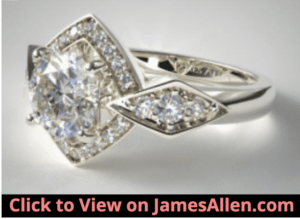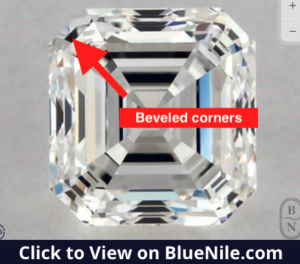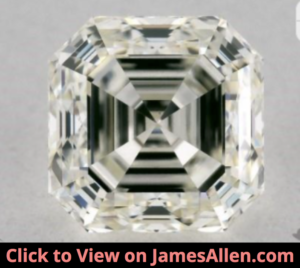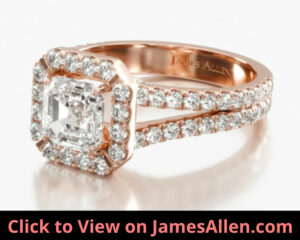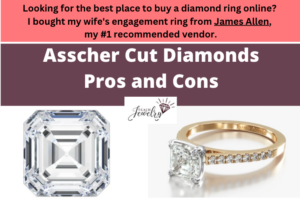
Round cuts are the most popular style of diamond for engagement rings, but there are many fancy shapes that offer an alternative to the traditional style.
One that can serve as a center diamond is an Asscher cut.
Let’s explore nine pros and cons of Asscher cut diamonds, staring with an overview, so you’ll know if it’s right for you.
What to Know About Asscher Cut Diamonds
The distinguishing features of an Asscher cut diamond are its square shape with a deep pavilion, cropped corners, and high crown. It has 58 step-cut facets that create a layered look known as a “hall of mirrors.”
Check out this one-carat Asscher cut from the vendor where I bought my wife’s engagement ring.
It’s in high resolution, so you can rotate the image on the vendor’s site 360 degrees to learn how it appears at every angle.
The edges are straight and then have a diagonal slant at each end, which results in four additional sides.
Asscher cut diamonds mimic the shape of an emerald cut, but its square appearance contrasts with the elongated aesthetic of the emerald.
They’re also available in distinct length-to-width ratios. Some are have a ratio of 1.0 as a perfect square, but others are stretch as much as 1.10.
If it’s between one and 1.05, it’ll resemble a square to the naked eye.
Its octagonal shape was developed in the early 1900s by the Asscher brothers, and it broke onto the scene as a common cut for engagement rings in the 2000s.
Pros
Vintage
One of the first steps in selecting which cut is best for you is understanding their styles.
Certain cuts exhibit traits that were renowned during certain periods as different designs rise and fall in popularity.
Check out the engagement ring below that includes an Asscher cut at its center.
It’s an Art Deco Geometric style with two marquise cuts flanking the middle diamond. Small round-cuts also surround the Asscher cut for added brilliance in a way that highlights its unique shape.
Asscher cuts are a vintage style diamond.
The use of older diamond cutting techniques means it’s less brilliant and has a subdued sparkle.
Many buyers choose to complement Asscher cuts with halo settings and intricate bands with milgrain or filigree.
It can be surrounded by one or two halos or tapered baguettes on each side.
If you’re interested in a contrast, the vintage diamond can be paired with a modern style, such as princess cuts along the shank.
Princess and Asscher cuts give the piece stronger brilliance while maintaining the overall vintage style.
Lacks Sharp Corners
Sharp corners on a diamond leave it vulnerable to chips if it’s dropped or struck against a hard surface.
The beveled corners on an Asscher cut prevent this issue.
I’ve highlighted those corners in this image.
The four ends that would normally be most prone to damage are instead given a layer of protection with its diagonal cut, in contrast to the sharp corners of baguette, princess, and trilliant cut diamonds.
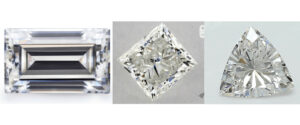
I still recommend you place Asscher cuts in a setting that protects its most susceptible areas.
The most common type is a four-prong setting that grasps each edge, like this engagement ring from James Allen.
In most cases, the prongs hold the shorter edges, but you can also find instances where prongs leave those areas exposed.
A bezel setting wraps the entire diamond in a ring of metal, offering the most protection for Asscher cuts.
Lower Cost-Per-Carat
Another pro of Asscher cut diamonds is they cost less per carat compared to round cuts.
Round cut diamonds are the most expensive because of the high demand, and cutters throw out a significant portion of the original diamond to form its round shape.
You can expect to pay 35-40 percent less per carat for an Asscher cut versus a round cut.
For example, I compiled the prices of both cuts from James Allen, an online retailer. For both round and Asscher cuts, I compared prices of diamonds with the following qualities:
- Carat weight: 1.00
- Clarity: VS2
- Color: I
The average price of a round cut with those traits is $4,875, with a range of $3,460-$5,720.
For the Asscher cuts, the average price is $2,987, and the range is $2,790-$3,380.
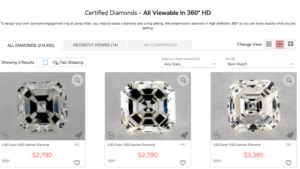
A closer comparison in price is Asscher versus radiant cuts.
The average price of a radiant cut from James Allen with those qualities is $3,015, which is almost identical to the cost of Asscher cuts.
If you’re searching for a more affordable cut or want to put that savings toward a larger diamond or its setting, Asscher cuts can be the right choice for you.
Multiple Types
There is more than one type of Asscher cut to choose.
Within the standard cut, they can have a length to width ratio of 1.00 to more than 1.08. Any ratio between 1.00-1.05 will look like a square to the naked eye. The Gemological Institute of America (GIA) also considers it a square cut.
If you stretch the ratio above 1.05, it will start to look like a rectangle and resemble an emerald cut.
There’s also a variation of the Asscher cut called the Royal Asscher.
Here’s an image of a Royal Asscher cut.
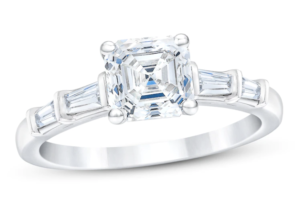
Try to identify how it’s different from the traditional style.
It’s designed by the same Asscher family that developed the original and features 74 step-cut facets compared to the standard cut’s 58 facets.
The crown of a Royal Asscher cut has more facets than an emerald cut with a deeper pavilion. It’s known as the world’s first patented diamond cut.
Whether you’re looking for variations within the traditional Asscher cut or want to explore the elegant Royal Asscher diamond, you have multiple styles to choose from within the category.
Cons
Shows More Color Compared to Brilliant Cuts
Colorless diamonds are the most valuable, and their value drops as strong tints of yellow or brown are present.
At the top of the GIA color scale is the “colorless” category (grades D-F), and as more color can be seen, the categories move from “near colorless” to “faint” and all the way down to “light.”
Some diamond cuts show more color than others. To find an Asscher cut that looks colorless to the naked eye, you’ll have to choose a color grade higher than you would for a round cut to achieve the same effect.
To illustrate, here’s one that earned a J color grade.
The yellow is obvious in the high-resolution image, and it would appear that way to the naked eye as well.
Most round cuts appear colorless if they’re graded H or higher. For an Asscher cut, I recommend G or above.
For example, here’s an Asscher cut with that grade.
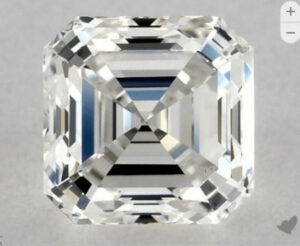
Any hints of color aren’t noticeable even with this degree of magnification.
The reason you have to choose a higher grade to achieve the same effect is its lack of brilliance means the white light doesn’t disguise the yellow as much, and the deep cut brings out color.
This principle is true for all step-cuts compared to brilliant cuts. You’ll have to pay for a higher color grade, but the lower cost-per-carat compensates for that.
Lack of Brilliance
Asscher cuts don’t exhibit strong brilliance, which is often the most sought-after trait because of how it affects the overall appearance.
High amounts of brilliance means white light will reflect off the diamond and back to the viewer when it twirls.
The reason Asscher cuts have less brilliance than brilliant cuts is because of its step-cut facets.
Their elongated shape isn’t ideal for collecting light and allowing it to bounce around inside the diamond.
Brilliant cuts, on the other hand, have triangle or kite-shaped facets conducive to light return. The way it’s shaped prevents light from leaking through the pavilion and culet.
A quality Asscher cut won’t appear dull, but when placed next to a round, princess, oval, or radiant cut, it’s light performance won’t compare.
If you’re most concerned about the diamond’s sparkle, don’t choose an Asscher cut.
One way to remedy this downside of an Asscher cut is to select the right setting.
By placing brilliant cut diamonds along the band, you can add sparkle to the piece even though the center diamond is an Asscher cut.
As an example, here’s an Asscher cut engagement ring with a halo and pave.
The round-cuts that complement the step-cut compensate for its lack of brilliance. You’ll have the uniqueness of the Asscher cut and a ring that still sparkles when it’s twirled.
Doesn’t Disguise Flaws and Inclusions
Inclusions are more visible in Asscher cuts compared to brilliant cut diamonds. These imperfections can include:
- Etch channels
- Cavities
- Feathers
- Twinning wisps
The strong brilliance of round cuts can hide inclusions, so ones given an SI1 clarity grade are often eye-clean.
This means that even though there are blemishes, they can’t be seen without magnification.
On the contrary, the deep, elongated facets on Asscher cuts result in more obvious flaws, whether it’s a white feather or dark spot.
If you want an eye-clean Asscher cut, there are some options at the SI1 clarity grade, especially diamonds less than one carat.
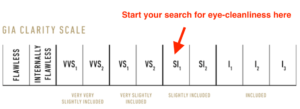
If you opt for a larger diamond, begin with ones graded VS2 if your goal is eye-cleanliness.
No Cut Grade from GIA
The GIA doesn’t grade the cut of Asscher diamonds because they’re isn’t a reliable way to determine its quality for fancy shapes.
Whether you choose a princess, marquise, emerald, or oval cut, it won’t receive a cut grade in the same way it will a clarity and color grade.
There are two solutions. The first is to view the diamond in person or through a high-resolution image. If the diamond appears dull or asymmetrical, that’s an indicator of a poor cut.
The other solution is to examine the grades it receives for the traits that make up a diamond’s cut, such as:
- Girdle thickness
- Symmetry
- Polish
- Depth
For example, this one-carat Asscher cut was given the following grades from the GIA:
- Polish: Excellent
- Symmetry: Excellent
- Girdle thickness: Slightly thick to thick
- Depth: 69.6%
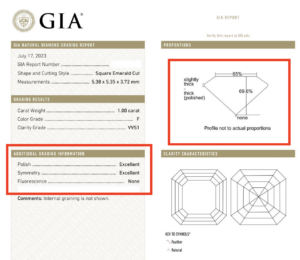
These traits are indicative of a quality cut. If the polish and symmetry were poor, or it had an extremely thin girdle, be wary of its cut.
By viewing the diamond and analyzing the GIA report, you can determine its cut quality.
Availability
Asscher cuts are available with a variety of length to width ratios, clarity and color grades, and carat weights. But because they make up a small percentage of diamond sales, there are fewer options available at most retailers.
For example, Blue Nile has more than 33,000 round cut diamonds 1.00 carats and higher for sale and 3,400 princess cuts. For Asscher cuts, there are only 1,100 available.
The same is true at James Allen. It’s inventory of round cuts of 1.00 carats or more is 38,000. For emerald cuts, there are more than 5,000 to choose from, but with Asscher cuts, there are 1,400 options.
If you’re looking for the diamond cut with the most options, both online and in-person, consider a more popular shape. Diamond stores often have limited inventory of Asscher cuts compared to others.
This further points to the popular of online diamond stores as an exceptional choice. If you walk into the typical brick-and-mortar location, there likely won’t be many Asscher cuts.
Size Appears Small
The size of a diamond is measured in carats, which is a unit of weight equal to 0.2 grams.
So two diamonds that each weight 0.5 carats are considered the same size, no matter their cut or how large or small they appear to the naked eye.
But some cuts appear larger than others because of the way the weight is dispersed.
For example, Asscher cuts generally appears smaller than round and oval cuts when placed next to each other.
Much of the Asscher cuts weight is beneath the table, not on its surface. Here’s a side-by-side comparison of those three cuts so you can see for yourself how their shape differs.
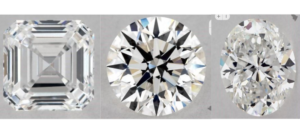
On the other hand, its lower cost-per-carat means you could choose a heavier Asscher cut compared to a round diamond and it cost the same.
Is an Asscher Cut Right For You?
Knowing the pros and cons of Asscher cut diamonds is the first step in learning if the cut is right for you.
Here are some indicators you should consider one:
- You want the ring to have a vintage style
- You’re looking for a lower cost compared to many brilliant cuts
- The square shape with beveled edges is appealing
- You want a square diamond that isn’t as vulnerable to chipping
- You prefer the elongated step-cut facets over brilliant cuts
Explore a variety and view how they pair with certain settings.
Many online jewelers allow you to pair any cut with their settings, so try styles such as solitaire, halos, and pave settings.
Once you pair an Asscher cut with the right setting, you’ll have the perfect ring for you.

Jacob Clarke
Jacob Clarke is the founder of TeachJewelry.com.
He earned an Applied Jewelry Professional Diploma from the Gemological Institute of America (GIA) and now brings you essential information about diamonds, settings, and more.
Jacob has consulted with leading jewelry brands, and his work has been cited in Clean Origin, Diamond Nexus and industry publications.
He's also a member of the International Gem Society.
He enjoys discussing jewelry with readers, so contact him with any questions at jacob.clarke@teachjewelry.com.

